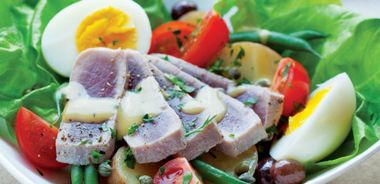Mediterranean Combination Salad

This versatile salad is hearty enough to be eaten as a meal. It can be best described as a vegetable salad with eggs and tuna. Its French name, Salade Niçoise, comes from the kind of olives used—niçoise, from the South of France.
Dressing
3 Tbsp (45 mL) red wine vinegar
2 Tbsp (30 mL) Dijon mustard
Salt and pepper to taste
1/3 cup (80 mL) extra-virgin olive oil
Whisk together vinegar, mustard, salt, and pepper in small bowl. Add oil in slow stream, whisking constantly.
Salad
8 small white or red new potatoes
1 lb (450 g) thin green beans
16 oz (450 g) tuna filet
Salt and pepper to taste
1 tsp (5 mL) extra-virgin olive oil
1 head butter lettuce, separated into leaves
8 small tomatoes, cut into wedges
4 large free-range eggs, hard-boiled, peeled and halved lengthwise (see below)
16 olives niçoise or other black olives
2 Tbsp (30 mL) capers, drained and rinsed
2 Tbsp (30 mL) fresh parsley, minced
Cook potatoes in saucepan filled with water until tender. Drain and cut according to your preference and add 2 Tbsp (30 mL) dressing.
Blanch beans in salted boiling water until bright green, about 2 minutes. Drain and place in bowl filled with ice-cold water to stop cooking process. Add to potatoes and stir to coat.
Season tuna with salt and pepper. Heat pan, add oil, and sear tuna on both sides leaving centre rare, 1 to 2 minutes per side.
To serve, arrange lettuce on large platter or 4 different plates. Add potatoes, green beans, tomatoes, eggs, olives, and capers. Place tuna on top of salad. Drizzle dressing all over, sprinkle with parsley, and season with additional salt and pepper to taste (optional).
Serves 4.
Each serving contains: 757 calories; 42 g protein; 34 g total fat (6 g sat. fat, 0 g trans fat); 73 g carbohydrates;
12 g fibre; 559 mg sodium
Place eggs in a saucepan big enough to fit them in one layer. Add water to cover them by 1 in (3 cm). Bring to a boil. Once boiling, remove from heat, cover, and let stand for 10 minutes. Remove the eggs and rinse under cold water to stop the cooking process.
Always make more hard-boiled eggs than you need so you can make egg salad or devilled eggs, eat them
as a snack, or bring them along in your lunch.
source: "Eggs", alive #353, March 2012




